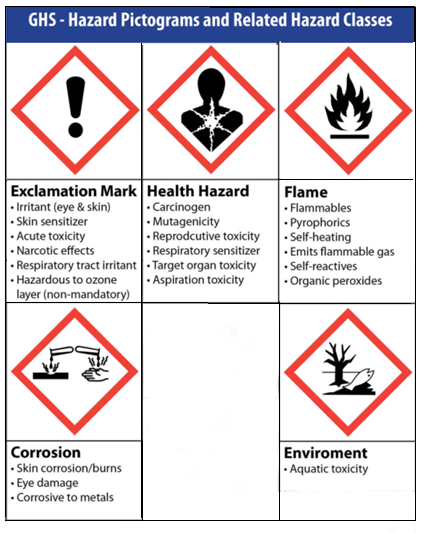Science Safety
The OCM BOCES Science Center would like to share with you our safety plan for our kit program and some suggestions for safety in your classroom. We have implemented safety practices based upon NSTA safety standards by:
- labeling kit items that are considered "chemicals" with relative information and hazardous index codes.
- providing disposable gloves in selected kits.
- providing sets of safety goggles in selected kits.
- providing safety handouts or posters in selected kits.
- substituting plasticware for glassware wherever possible.
- using solutions diluted to meet the needs of the activity.
Safety Labels
Labels are applied by the Science Center to containers for materials that have been re-packaged and require hazard notification. Material requiring hazard notification sent in the original container should be appropriately labeled by the supplier.
Sample Safety Label
Label Components
- Product Identifier
- Signal Word
- Hazard Statement
- Pictogram
- Supplier
Label Pictograms used by the Science Center

SDS (Safety Data Sheets)
Safety Data Sheets are documents with specific Hazard Identification information, First Aid measures and other item specific information.
*Indicates repackaged material that is in-house safety labeled.
Classroom Science Safety Checklist
- Have and enforce a safety contract signed by students and parents.
- Identify medical and allergy problems for each student to foresee potential hazards.
- Assess and minimize barriers for students with disabilities.
- Model, post and enforce all safety procedures. Display numbers for local poison control centers and emergency agencies.
- Know district and state policies concerning administering first aid and have an adequately stocked first-aid kit accessible at all times.
- Report all injuries, including animal scratches, bites, and allergic reactions, immediately to appropriate personnel.
- Be familiar with your school's fire regulations, evacuation plans, and the location and use of fire fighting equipment.
- Post and discuss emergency escape and notification plans/emergency phone numbers in each space used for science activity.
- Make certain that you, your students and all visitors are adequately protected when investigations involving glass, heat, chemicals, projectiles, or dust-raising materials are conducted. (goggles, gloves, water source)
- Keep spaces where science activities are conducted uncluttered.
- Limit the size of students working in groups to a number that can safely perform the activity without causing confusion and accidents.
- Do not permit eating and drinking in any space where science investigations are conducted.
- Do not store chemicals and biological specimens in the same refrigerator used for food and beverages.
- Do not use mercury thermometers with elementary students.


 Careers
Careers Staff Only
Staff Only Personnel
Personnel Sub Call-In Service
Sub Call-In Service Health & Safety
Health & Safety